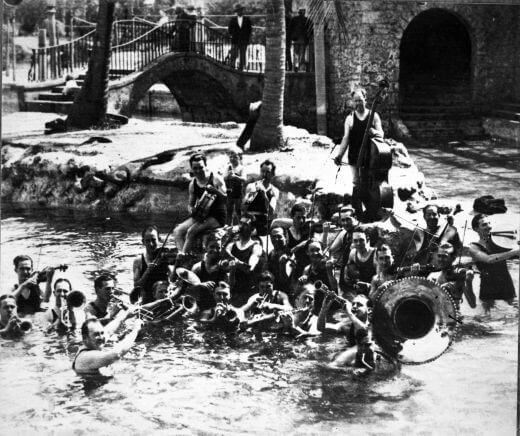A Word for the Year
Stuart A. Chase

Paul Whiteman’s band playing in the Venetian Pool, Coral Gables, 1925. Photo: City of Coral Gables, courtesy HistoryMiami
“CULTURE IS A WORD THAT WE SEEM TO BE RELYING ON MORE AND MORE. IT ALLOWS US TO IDENTIFY AND ISOLATE AN IDEA, ISSUE, OR GROUP WITH SERIOUSNESS,” PETER SOKOLOWSKI, EDITOR-AT-LARGE FOR MERRIAM-WEBSTER, SAID IN A STATEMENT. “AND IT’S EFFICIENT: WE TALK ABOUT THE ‘CULTURE’ OF A GROUP RATHER THAN SAYING ‘THE TYPICAL HABITS, ATTITUDES, AND BEHAVIORS’ OF THAT GROUP.”
—TIME MAGAZINE, DECEMBER 2014
One might think it would have been big news in museum circles when Merriam-Webster proclaimed its word of the year in 2014 to be “culture.” Museums are, of course, not just repositories for but also proponents of culture, educational institutions designed to expose visitors to art, artifacts, and ideas dating from before the dawn of civilization to the spectacular now, depending on their mission and purview. But the parameters for Merriam-Webster’s distinction are defined by a single factor: the word was the most frequently searched definition in 2014. How heartening that the work museum professionals devote themselves to is at the top of the list of topics in which the general public is interested. At the risk of speaking for others in my profession, we believe that culture, in its broadest sense, is a unifying force that brings people together and builds community.
As it turns out, Merriam-Webster’s primary definition of culture—“the beliefs, customs, arts, etc., of a particular society, group, place, or time”—may not have been the concept that these multitudes of Internet searchers were looking for. The secondary definition—“a particular society that has its own beliefs, ways of life, art, etc.”—begins to draw lines between groups of people. The third—“a way of thinking, behaving, or working that exists in a place or organization (such as a business)”—makes even further distinctions. It seems most of the searches of this term were in the form of phrases linked to the third definition, such as pop culture, consumer culture, celebrity culture, and military culture.
Going back to the primary definition, art is a subset of culture, which also encompasses elements such as history, religion, language, and cuisine. Culture is the basis of civilization; in certain social spheres, one can’t be viewed as civilized without exposure to and appreciation of culture, which in this usage is a stand-in for the arts.
Here in Miami, we are blessed with a plethora of cultures (in the second-definition sense of the word) from around the globe. It’s nearly impossible to keep track of all the different languages I hear on any given day. This is a welcome contrast to the rural New England (and nearly homogeneous) region from which I relocated to direct HistoryMiami.
However, while this city is vibrantly multicultural, I’ve noticed scant cross-cultural interchange. Certainly there have been some important initiatives toward this end, but they don’t go far enough.
As newcomers here, my wife and I are thrilled to be able to explore the music, dance, cuisine, and all-around experience of diverse cultures. Yet each time we attend an event such as Big Night in Little Haiti, we sadly note few non-Haitians among the crowd. Rather than a melting pot, Miami is more like an Indian thali, a selection of various tasty dishes, each in its own defined space, which rarely come together. What a delicious stew would result from more transcultural interaction.
Traditionally, small communities in Miami have had their own specific societal norms, for example, the Coral Gables
Venetian Pool appealed to a small portion of those living in the suburbs, and has been the venue for numerous cultural events since 1925, including the Bathing Beauties Parade and the Paul Whiteman band.
What is the cause of this self-imposed segregation among Miami’s diverse cultures? There’s an element of tribalism, of staying in one’s own comfort zone, and perhaps a lack of inherent curiosity.
And here is where the city’s cultural institutions can play a role. With creative, engaging programming, museums, performing arts centers, and other venues with a goal of education, enlightenment, and—yes—entertainment can spark curiosity and act as agents to break down the barrier between cultures via culture, thereby building a more fully engaged community. It is contingent upon us to create exhibitions, performances, talks, screenings, classes, and happenings that bring people 1) through the door and 2) together, with a common focal point or experience. Curiosity can lead people to take action, and taking action with others can foster community and civic
engagement. People from diverse cultures who find themselves doing something together often develop relationships that bridge those cultural divides.
Clearly, these bridge-building events must be affordable and accessible to all and they must be the types of experiences that transcend the high/low culture rift. Above all, they must appeal to a wide range of people to be successful in using culture to get people to learn more about other cultures and ultimately bring these cultures together to build a more cohesive community, each with its own identity, but sharing a common civic sense. Miami, rich in cultures and cultural institutions, has the means, entrepreneurial spirit, and motivation to make this happen.
STUART A. CHASE is the director of HistoryMiami.










